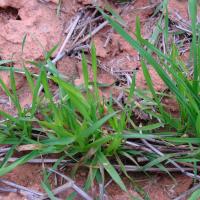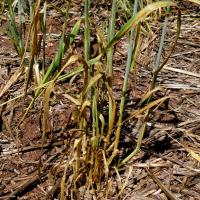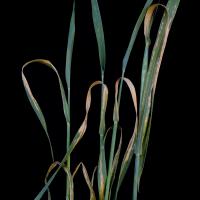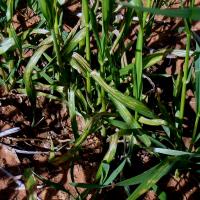Diagnosing zinc deficiency in wheat
Most soils in Western Australia (WA) were zinc deficient in their natural state. Zinc deficiency has become more common in young wheat plants emerging in drying soil but this deficiency is usually transitory and disappears when rainfall re-wets the topsoil.
What to look for
- Patchy growth, of stunted plants with short thin stems and usually pale green leaves.
- Heavily limed soils, sands and gravels or alkaline grey clays tend to be most affected.
- Zinc deficiency symptoms are usually seen on young seedlings early during the growing season.
Paddock
- Young to middle leaves develop yellow patches between the mid-vein and edge of the leaf and extend lengthways towards the tip and base of the leaf. This stripe may occur only on one side of the mid-vein.
- The areas eventually die turning pale grey or brown
- The leaf changes from green to a muddy greyish-green in the central areas of middle leaves.
- Stunted plants often have 'diesel-soaked' leaves, showing dead areas about halfway along the leaves, causing them to bend and collapse in the middle section.
- Maturity is delayed
Plant
What else could it be
| Condition | Similarities | Differences |
|---|---|---|
| Diagnosing manganese deficiency in wheat | Leaf kinking, pale lesions, streaks and wilted plants | Manganese deficient plants are very pale, are more common as patches of limp dying plants and lack the parallel necrotic tramlines adjoining the midrib |
| Diagnosing wheat streak mosaic virus | Stunted plants with many tillers and striped leaf lesions | Zinc deficient plants have pale linear spots or lesions that can develop into parallel 'tramlines' and lack vivid yellow streaks towards the leaf tip |
| Diagnosing yellow dwarf virus | Stunted plants with many tillers and striped leaf lesions | Zinc deficient plants have pale linear spots or lesions that can develop into parallel 'tramlines' and lack vivid yellow streaks towards the leaf tip |
Where does it occur?

Soil type

Dry conditions

Spraying herbicide
- Most sandy surfaced soils required copper and zinc treatments when initially cleared for agriculture.
- Zinc is relatively immobile in soil and can become unavailable to crops in dry soil.
- Where soil levels are marginal, zinc deficiency can be induced by applications of lime, high nitrogen fertiliser, and copper fertiliser.
- The use of root-pruning herbicides, particularly groups A and B can induce zinc deficiency.
- Zinc deficiency is more common in high pH and clay soils.
Management strategies

Spraying foliar

Seed treatment

Soil application
- Foliar spray (effective only in current season) or drilled soil fertiliser.
- Zinc foliar sprays need to be applied as soon as deficiency is detected to avoid irreversible damage.
- As zinc is immobile in the soil topdressing is ineffective, only being available to the plant when the topsoil is wet.
- Mixing zinc throughout the topsoil improves availability due to more uniform nutrient distribution.
- Zinc drilled deep increases the chances of roots being able to obtain enough zinc when the topsoil is dry.
- Zinc seed treatment is used to promote early growth where root disease is a problem, but the level is lower than a plant needs in the current season.
- Zinc present in compound fertilisers often meets the current requirements of the crop.
How can it be monitored?

Soil test


Tissue test
- A soil test provides at best a rough guide to soil zinc status.
- Whole-top plant test provides a rough guide if paired good/ poor samples are taken, but this should be confirmed with a youngest emerged blade (YEB) test.
- YEB Levels below 10 milligrams per kilogram (mg/kg) indicate zinc deficiency.
Further information
Where to go for expert help
Page last updated: Friday, 26 June 2015 - 8:14am





